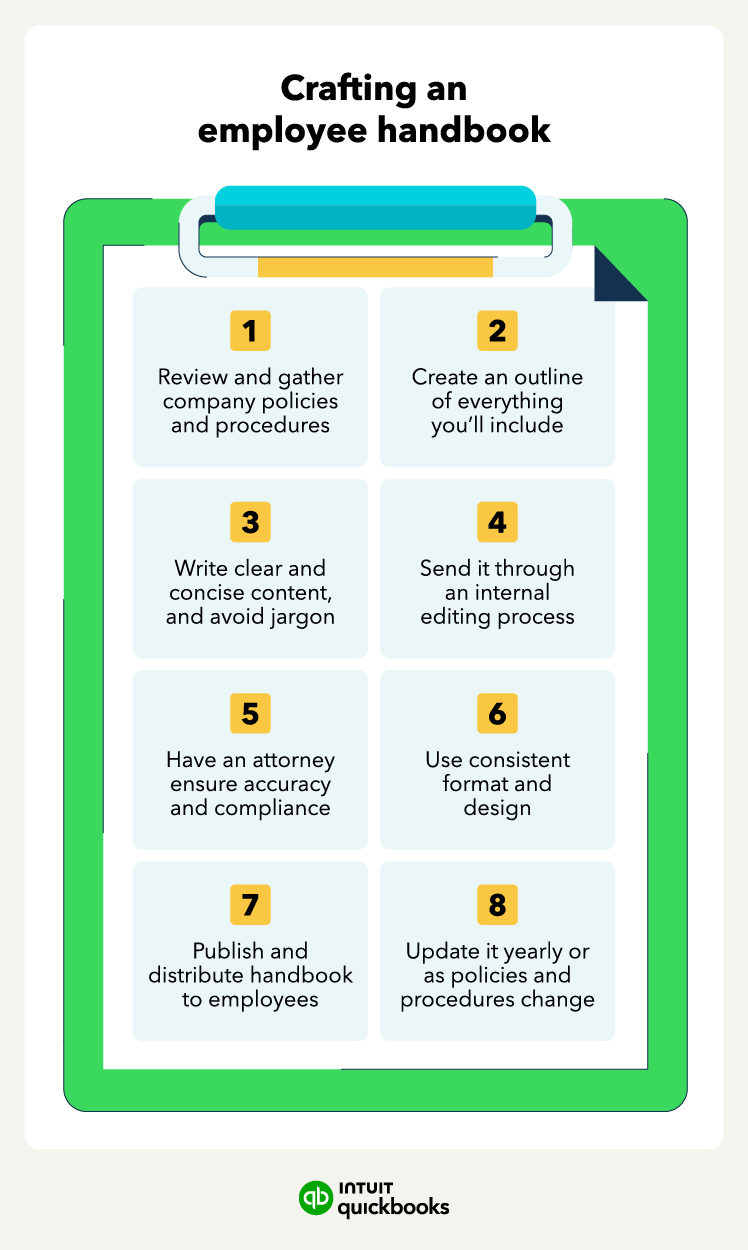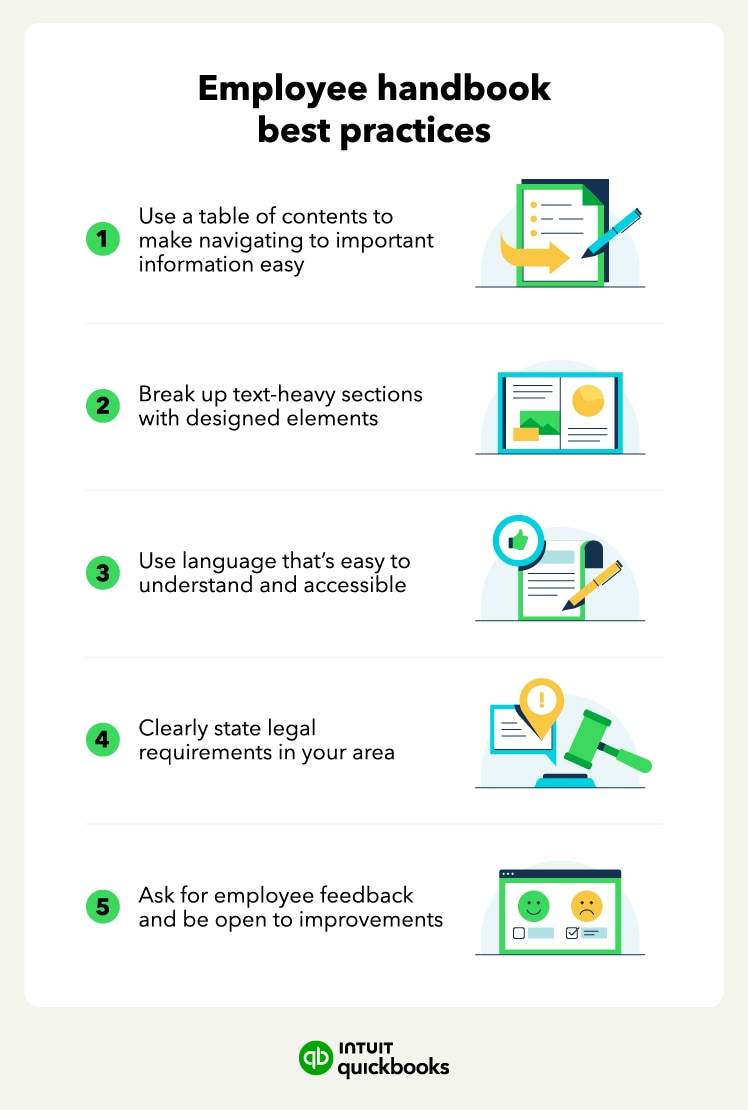

As a small business owner, it’s always helpful to have your staff on the same page regarding company policies and procedures. This can ensure that your team members know what you expect of them and what they can expect from you. When these expectations are well-communicated in advance, you can avoid misunderstandings, which could include legal liability.
The best way to codify business policies and expectations is to create an employee handbook that documents your company’s procedures , policies, and expectations. Keep reading to learn how to write an employee handbook, and snag our free template to help you get started.
A great employee handbook should not only effectively outline company policies but should also make the experience of using the handbook as easy and engaging as possible for the employee. If heavy blocks of text or disorganization make reading or understanding the handbook difficult, employees may set your handbook aside unread.
To make your handbook as digestible as possible, here are some employee handbook guidelines:
To make sure you cover all the necessary information, here’s what you should include in an employee handbook.

Begin by offering a welcome message and introducing your company to employees. You should also mention your company’s mission statement and any company values.
Your mission statement describes where you’re headed as a company. If your staff understands your mission statement, they may feel a stronger bond with your company and be more passionate about the work. Company values can help you create and establish a strong company culture.
In your introduction, include legal information on employment, such as an equal opportunity statement and an at-will employment statement.
The Fair Labor Standards Act (FLSA) guarantees employees certain rights, like overtime, depending on their classification status. Outline what classifies an employee as full-time, part-time, or contracted, and what benefits you’ll offer at each classification status.
The handbook is your opportunity to set expectations, and you should include all relevant policies. For example, what’s your policy regarding cell phone use during work hours? Where should employees take their lunch break? State all policies in writing.
In addition to policies unique to your company, be sure to include policies on basic employee rights and privileges, such as:
Clearly outlining the policies and regulations ensures employees know what you expect from them and their rights as an employee at your business.
Pay your team and manage benefits with the #1 payroll service provider.The handbook should also explain your employee benefits , which can be a powerful incentive to retain workers over time. Don’t forget to include benefits such as the following:
You can also include any additional benefits you offer employees, such as reimbursement budgets, app subscriptions, travel stipends, or more. Include any stipulations around using these benefits, like saving receipts or maintaining a certain number of work hours.
Worker safety is a top priority, so make sure your handbook contains a section on safety explaining how your firm will deal with an employee injury, a crime (such as robbery), or a natural disaster (such as flood or fire). Each of these events is stressful, and your workers should understand how your company would address these issues.
If your company uses any personal protective equipment, outline any standards around using it. For example, restaurant owners may want to include information about knife safety by using chain mail gloves.
Don’t forget to look up any laws that may apply to you set forth by the Occupational Safety and Health Administration (OSHA). OSHA maintains standards to guarantee workplace safety, which vary across industries. For example, one OSHA requirement states salons must maintain updated Material Safety Data Sheets (MSDS) for every product used.
Delineate policies that address all issues in creating a safe and secure work environment. Ensure you are in compliance with laws set forth by the Occupational Safety and Health Administration .
Communication and technology policies will vary from workplace to workplace, but most should have several components. Set expectations for how employees should interact online and what content they can view at work, such as prohibiting visiting websites with questionable content.
You should also address the area of social media, such as forbidding posting personal company information on sites like Twitter and Facebook. Encourage proper cell phone etiquette, including turning the devices off during meetings and minimizing their use while on the job.
In this section, clearly outline what work you expect from employees. This includes job duties, promotions, and terminations. Clearly outlining job expectations not only helps employees meet productivity standards but can also provide them with a road map for promotions or other growth opportunities. You can also note whether you’ll have employee performance reviews and outline when they’ll take place.
If your company maintains grounds for termination based on poor performance, including that information here is especially important. While you don’t need to explain the entire review process, let employees know how long it usually takes and where they can find more information.
At the end of your employee handbook, include a summary and acknowledgment page. Once signed and returned, this page will become a record that your employee read and understood the information outlined in your handbook.
It’s important to keep a record of this signed document in your employee records . This way, if a disciplinary issue arises, you have proof that your employee agreed to workplace standards in your handbook.

When starting out, writing your employee handbook may feel like an overwhelming process. Handbooks are often dozens of pages long and steeped in legal ramifications. To make the process more manageable, break it down into simple steps.
Here’s how to create an employee handbook from start to finish.
Before writing your handbook, ensure you have the most up-to-date information. Review your company policies and procedures to ensure no recent changes affect your writing and creation process.
Most business owners create company policies as they run the business. You may, for example, have a process workers use to request time off. You’ve emailed a memo that explains the policy, but the information is not in a formal employee handbook. As a result, you’re not starting the writing process at zero because you’ve already created some policies.
Once you’ve reviewed your policies and procedures, create an outline of everything you will include in your employee handbook. This includes any federal, state, or local requirements. Outlining your handbook first ensures you won’t miss any important information that can delay your process later on.
For example, a restaurant owner must manage many workers and deal with employee turnover, so the employee handbook can focus on hiring and termination policies.
After you outline the handbook and start writing, use clear and simple language. Avoid jargon so your staff can understand your policies and provide links to more complex topics, such as laws and regulations. While a clearly written handbook will reduce questions, encourage your employees to ask if a policy is unclear to them.
Send your handbook through an internal editing process to ensure your company voice and tone are present and consistent. Check for any errors or typos that can make your handbook look unprofessional.
Your handbook must address a variety of employment and legal policies, including overtime pay , workplace harassment policies, and other issues. An employment attorney should review your manual to ensure you’re in compliance with federal, state, and local laws and regulations.
Once your internal team and an attorney review your text, you can send your copy to be formatted and designed. This helps ensure your handbook is readable and allows you the chance to include company branding elements.
Many companies publish and distribute their employee handbooks electronically. While this is a great option to keep costs low, you should make physical copies of the handbook available to employees upon request.
Your employee handbook is only useful if it remains current. Should any company policies change, update your handbook to stay consistent. It’s also a good idea to recheck federal, state and local laws yearly to ensure your handbook is always legally sound.
Need help starting your own handbook? Our employee handbook template outlines important sections to consider and provides advice on how to fill in the blanks with your company’s info. Whether you need to know how to write an employee handbook for a small business or enterprise-size operation, this template can help you get started.


Creating an employee handbook can be time-consuming—and you may think it’s not necessary. However, operating your business with a handbook can bring many benefits.

Here are some of the benefits you’ll gain by writing an employee handbook:
The handbook should also explain the benefits you offer employees, which can be a powerful incentive to retain workers over time. A handbook helps your business comply with federal, state, and local laws and should provide a confidential system that workers can access if they believe a policy or law has been violated.
Creating your employee handbook is an important step toward running a successful business. Not only will your handbook reduce your potential legal liability, but it will also make it easier to manage your staff and stay organized.
Your handbook serves as a road map for employees. It should tell them how to meet current job expectations and provide information about growing within the company. Commit to create your employee handbook sooner rather than later.

Your employee handbook shouldn’t include legal documents, which should be given to employees separately, and specific work processes and job descriptions to avoid having to update the handbook each time they change.
Does every company have to have an employee handbook?Employee handbooks are not required by law, and you don't need to have them if you communicate frequently with your staff, and your workers perform well and seem to be content. However, it is an important document that can benefit your business — especially having policies and procedures in writing.
What is the purpose of an employee handbookThe purpose of an employee handbook is to provide essential information and guidance about company policies, procedures, expectations, and guidelines.
QuickBooks Online Payroll & Contractor Payments: Money movement services are provided by Intuit Payments Inc., licensed as a Money Transmitter by the New York State Department of Financial Services, subject to eligibility criteria, credit and application approval. For more information about Intuit Payments Inc.’s money transmission licenses, please visit https://www.intuit.com/legal/licenses/payment-licenses/ .
Recommended for you
Employee onboarding: A step-by-step guide with our best strategies

Starting a business
How to write a mission statement for your business: A step-by-step guide
January 26, 2022

PTO payout: What is it and how does it work?
October 21, 2022
We provide third-party links as a convenience and for informational purposes only. Intuit does not endorse or approve these products and services, or the opinions of these corporations or organizations or individuals. Intuit accepts no responsibility for the accuracy, legality, or content on these sites.
**Product information
QuickBooks Live Assisted Bookkeeping: This is a monthly subscription service offering ongoing guidance on how to manage your books that you maintain full ownership and control. When you request a session with a Live Bookkeeper, they can provide guidance on topics including: bookkeeping automation, categorization, financial reports and dashboards, reconciliation, and workflow creation and management. They can also answer specific questions related to your books and your business. Some basic bookkeeping services may not be included and will be determined by your Live Bookkeeper. The Live Bookkeeper will provide help based on the information you provide.
QuickBooks Live Full-Service Bookkeeping: This is a combination service that includes QuickBooks Live Cleanup and QuickBooks Live Monthly Bookkeeping.
1. QuickBooks Online Advanced supports the upload of 1000 transaction lines for invoices at one time. 37% faster based off of internal tests comparing QuickBooks Online regular invoice workflow with QuickBooks Online Advanced multiple invoice workflow.
2. Access to Priority Circle and its benefits are available only to customers located in the 50 United States, including DC, who have an active, paid subscription to QuickBooks Desktop Enterprise or QuickBooks Online Advanced. Eligibility criteria may apply to certain products. When customers no longer have an active, paid subscription, they will not be eligible to receive benefits. Phone and messaging premium support is available 24/7. Support hours exclude occasional downtime due to system and server maintenance, company events, observed U.S. holidays and events beyond our control. Intuit reserves the right to change these hours without notice. Terms, conditions, pricing, service, support options, and support team members are subject to change without notice.
3. For hours of support and how to contact support, click here.
4. With our Tax Penalty Protection: If you receive a tax notice and send it to us within 15-days of the tax notice we will cover the payroll tax penalty, up to $25,000. Additional conditions and restrictions apply. See more information about the guarantee here: https://payroll.intuit.com/disclosure/.
Terms, conditions, pricing, special features, and service and support options subject to change without notice.
QuickBooks Payments: QuickBooks Payments account subject to eligibility criteria, credit, and application approval. Subscription to QuickBooks Online required. Money movement services are provided by Intuit Payments Inc., licensed as a Money Transmitter by the New York State Department of Financial Services. For more information about Intuit Payments' money transmission licenses, please visit https://www.intuit.com/legal/licenses/payment-licenses/.
QuickBooks Money: QuickBooks Money is a standalone Intuit offering that includes QuickBooks Payments and QuickBooks Checking. Intuit accounts are subject to eligibility criteria, credit, and application approval. Banking services provided by and the QuickBooks Visa® Debit Card is issued by Green Dot Bank, Member FDIC, pursuant to license from Visa U.S.A., Inc. Visa is a registered trademark of Visa International Service Association. QuickBooks Money Deposit Account Agreement applies. Banking services and debit card opening are subject to identity verification and approval by Green Dot Bank. Money movement services are provided by Intuit Payments Inc., licensed as a Money Transmitter by the New York State Department of Financial Services.
QuickBooks Commerce Integration: QuickBooks Online and QuickBooks Commerce sold separately. Integration available.
QuickBooks Live Bookkeeping Guided Setup: The QuickBooks Live Bookkeeping Guided Setup is a one-time virtual session with a QuickBooks expert. It’s available to new QuickBooks Online monthly subscribers who are within the first 30 days of their subscription. The QuickBooks Live Bookkeeping Guided Setup service includes: providing the customer with instructions on how to set up chart of accounts; customized invoices and setup reminders; connecting bank accounts and credit cards. The QuickBooks Live Bookkeeping Guided Setup is not available for QuickBooks trial and QuickBooks Self Employed offerings, and does not include desktop migration, Payroll setup or services. Your expert will only guide the process of setting up a QuickBooks Online account. Terms, conditions, pricing, special features, and service and support options subject to change without notice.